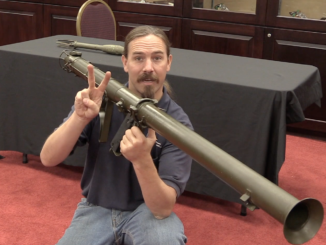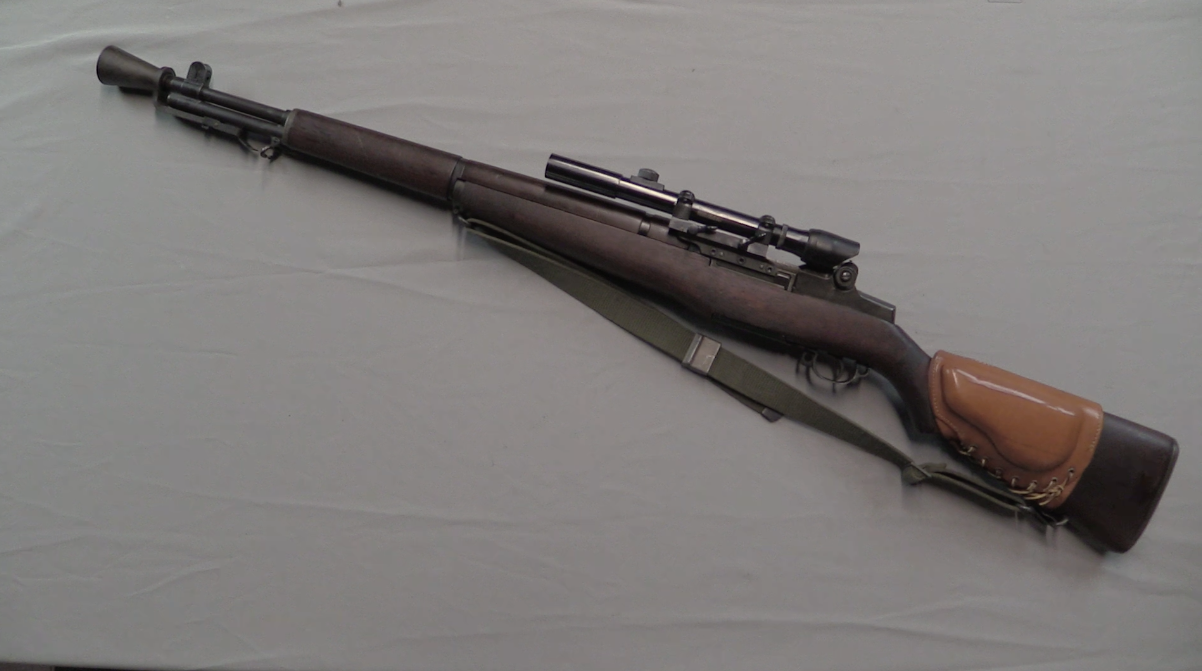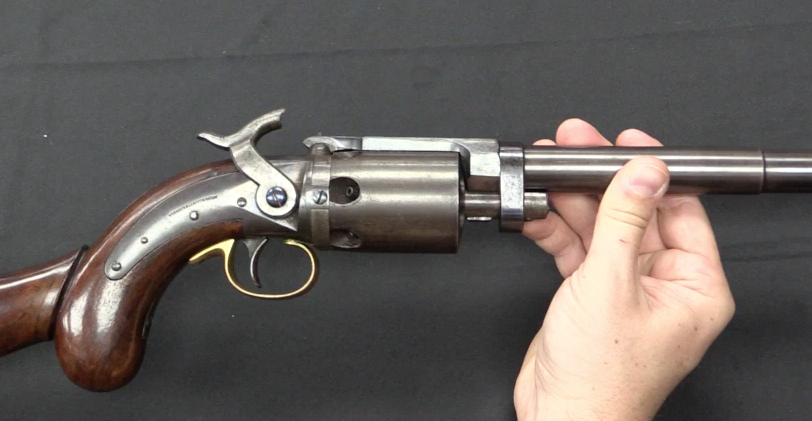The M1878 was the last new rifle produced by the Sharps company before it went out of business in 1881. It was the invention of none other than German gun designer Hugo Borchardt, better known for his C93 Borchardt automatic pistol (generally considered the first commercially successful automatic pistol). Borchardt was brought in as superintendent of the Sharps company in 1876, and his rifle was well ahead of its time. Its use of coil springs, a striker-fired mechanism, and sleek lines gave it an unusual appearance for its time, and hindered sales. It would not be until after the company has dissolved that the Schützen community would begin to truly appreciate the potential of the Sharps-Borchardt rifle.
The rifle in this video is a Military Pattern M1878 in .45/70 caliber, which is the most common type originally manufactured.




Very nice rifle. A sporter version would be a quite viable hunting rifle even today. (No, I don’t suggest one should buy and sporterize the rifle in question…)
Borchardt Rifle Corporation
http://brcrifles.com/
will happily make a new one for you for $8250
“Its use of coil springs, a striker-fired mechanism, and sleek lines gave it an unusual appearance for its time, and hindered sales.”
I am wondering of price of M1878 Borchardt in 1870s, do you know it? I doubt in that the external appearance was only cause of low sales number.
Just shows that manufacturing is manufacturing; Borchardt worked for a time at the Singer Sewing Machine Company, then went on to design the first mass-produced auto loading pistol. During WWII, Singer tooled up to manufacture M1911A1 pistols. If you can make one, you can make the other…
Don’t know if it was the same company Woff linked to, but I remember seeing new Borchardts in a profusion of barrel lengths and calibers in Guns Illustrated (the ads-only, no articles edition of Gun Digest) when I was a kid in the early 70s. Don’t think I ever saw one in the flesh, I seem to recall that the price was 3 or 4 times the price of a Ruger #1.
Tom is right, if you can make a sewing machine or a manual typewriter (Remington-Rand, no connection to Remington Arms I think) you can make a 1911. Actually, I’m not sure if any of the slides on the WW2 parts-gun 1911s on my submarine circa 1979 were made by Colt or not. May have been one or two, but I remember Singer, RR, and Ithaca.
My father recently gave me a Colt-Sharps in .22-250 that he purchased in the ’70s. That is probably the rifle that you remember, Jim. It is based on the Sharps-Borchardt action and was produced in very limited numbers. This one is LNIB without sights. I am debating as to whether or not I should scope it and shoot it or leave it alone. It has a trap door in the stock with slots for spare cartridges and is beautifully finished. It’s not something I would normally collect, but it is a gift from my father so I don’t plan on selling or trading it. He was a big Browning and Colt collector back then, and has been slowly passing on his stuff to me as his health declines and is in his last year or so. They’ll probably sit in their boxes just as they have for the past 40-50 years. Now, when I die, my daughters who have no interest in guns, are going to have a fire sale and blow it all on clothes and shoes. 🙁
The Sharps-Borchardt is one of the finest older weapons I have ever shot! In 1962 while attending Louisiana Tech one of our Gun Club members kept talking about these “old rifles” his father had. He was not overly interested in such things and could not tell me what they were but insisted that one was a “Buffalo Gun” and very old. He finally brought it to school and when he showed it to me I was puzzled to say the least. It was in almost brand new condition. It was a Sharps-Borchardt in either Sharps .45-110 or Sharps .45-120 caliber. I believe it was the latter because the cases were 3¼ inches long. The first thing I noticed was that there was no external hammer like other Sharps rifles I had shot. He brought cartridges and loading dies. It had a heavy octagon barrel instead of the round barrel like the one in the video and I believe it had “Express” engraved on the barrel. We took it to the range and I got to shoot it almost every afternoon for a week. It weighed almost 20 pounds if I remember correctly and was deadly accurate with a surprisingly mild recoil for this chambering. Mr. W. H. (Walter) Womack) from Shreveport told me later that he had seen this model rifle at Camp Perry (shooting a Sharps .45-90 Bottleneck I believe) when he first started going there and they were unbelievable at 1,000 yards. I always wanted one but finally accepted the fact that they would probably be worth more than my house, car, truck, boat and shop combined at the time.
Don’t give up on finding the right one just yet. There are a few out there, and you never know when you’ll stumble into the right deal. Some of the best pieces I own came from older collectors who I got to know while attending shows and shops as a young man. Over the years, they became friends and mentors, and while expressing interest in certain items in their collections, I never tried to get them to sell them to me. Then, as time passed, they would offer them to me at their original purchase price, or, on a couple of special occasions, simply place them in my hands with an “I know you’ll take good care of her.” There are a couple of young relatives of mine who will one day get the same from me.
Nice! I understand that the hammerless rifles did turn off buyers (and the price tag likely turned even more folks away) in America because they would claim there was no way to tell if it was in fact ready to shoot something (Ward-Burton accidents didn’t help). But if this had been sold in Europe, I think quite a few people might have wanted it. By 1878, Vetterlis, Dreyses, and Mausers were already in service and their users would have become accustomed to having a long arm with a striker-fired mechanism.
Given a choice, which of the rifles below would you pick if you went searching for a lost friend in the deep dark woods? Remember that firepower isn’t all that matters if your ammunition runs low [evil laugh].
1. Sharps-Borchardt
2. Werder “lightning”
3. Krag-Petersson repeating falling-block
4. Martini-Henry
5. Trapdoor Springfield
6. Snider-Enfield
7. Winchester 1886
8. Vetterli 69/71
9. Lebel “L’Africaine” chambered for .445 Nitro
10. Type 38 Arisaka with Type 30 bayonet in place
Joke choice: Mauser C77 falling block pistol, user must be very stealthy…
Pick a gun, ANY GUN! [insert maniacal laughter here]
Of all my guns I would pick my Type 99 Arisaka 7.7mm; I bought my first one from a farmer in Ruston, La for $5.00. Since, I have used it more than the rest combined and still absolutely trust it. P. O. Ackley once told me it was, up until then, the strongest action made. I have shot everything from cast slugs to “boughten bullets” to 00 Buckshot with squib loads on everything from squirrel to a 587# hog. It has the chrome-lined barrel, mono-pod and anti-aircraft sights and is still 100% original. I can take it and my “backpack kit” (a set of Ideal loaders/dies, primers, a set of .30 cal bullet molds [don’t need resizing to shoot in a 7.7mm/.311 cal. rifle], a pocket-full of “Double Ought Shot” and a pound of powder) and do okay. If need be I have shot with black powder with no problem. And by the way, I have a 7.7 “booby-trap” version with a cast-iron receiver that was used as a training rifle with black powder and when worn out was left behind for a souvenir collector to pick up and get his head blown off with. A man brought it to me to load him some rounds and I wound up giving him $100.00 for it to keep him from doing something REALLY stupid! Neither they nor my sporterized carbine are for sale
A footnote: while in the Marines I qualified with my Rem. 40-A and my M-14 Sniper Version. Then I qualified with my 99 just for fun. All the others were really having a hoot until I started shooting. In the 53 years I have owned it I have never put a commercial round through it … only handloads and only reloaded by myself. And no one else has ever shot it since I brought it home.
I didn’t see or hear one dang thing in that video that I didn’t know in grade school — and I don’t mind a bit. I loved looking at that old iron, and hearing it click as it worked, and go bump! on the bench. One of the best one-hole rifles of the 19th. century, 20th. too.
I believe that the auto-safety feature could be disabled for military buyers. I even half-believe I read that it can be disconnected by taking the action apart and switching something. But I said grade school, didn’t I? So don’t quote me; you’d probably regret it.
Well, all right, I didn’t know that old Hugo B. ever made sewing machines, but it doesn’t surprise me. Those old-time machinists could make anything.